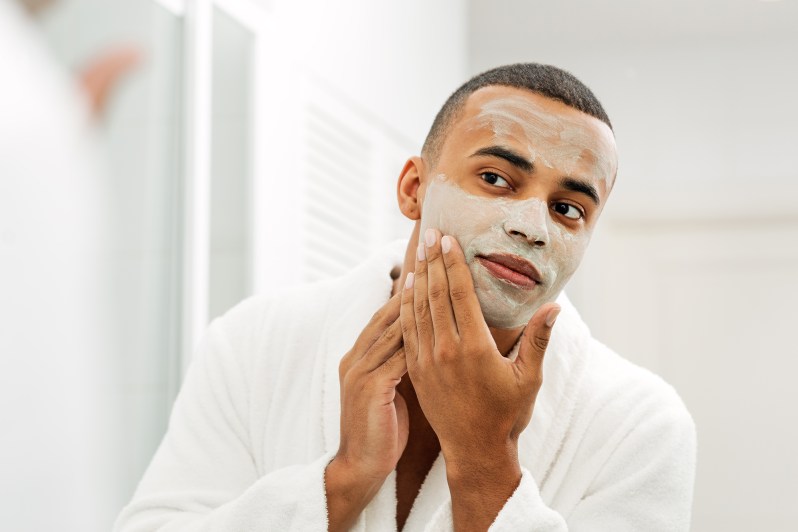
Ugh, acne. Is there anything more annoying than having clear skin one second, then breaking out with pimples overnight? As a pre-teen who regularly broke out with bumps, zits, and sores, I feel as though I’m only just now getting over the traumatic toll these blemishes caused me. And while my breakouts are few and far between these days, I’m left struggling with something that’s possibly even more frustrating than acne itself: How to get rid of acne scars.
Yep, although I’ve finally figured out how to treat and take care of my skin, I’m left with the ghosts of pimples’ past. Though I wish I could say I’m not bothered by them, I have to admit that I am. Like, really, really am. There are a lot of acne spot treatments for men, but it’s better to consult an expert. So, I thought it’d be beneficial for me, and everyone who comes across this, to do a little digging to find out how to get rid of acne scars once and for all. To do this, I spoke with Vichy Medical Consultant, Dr. Erin Gilbert, who provided me with a ton of helpful tips and insights.
Atrophic scars
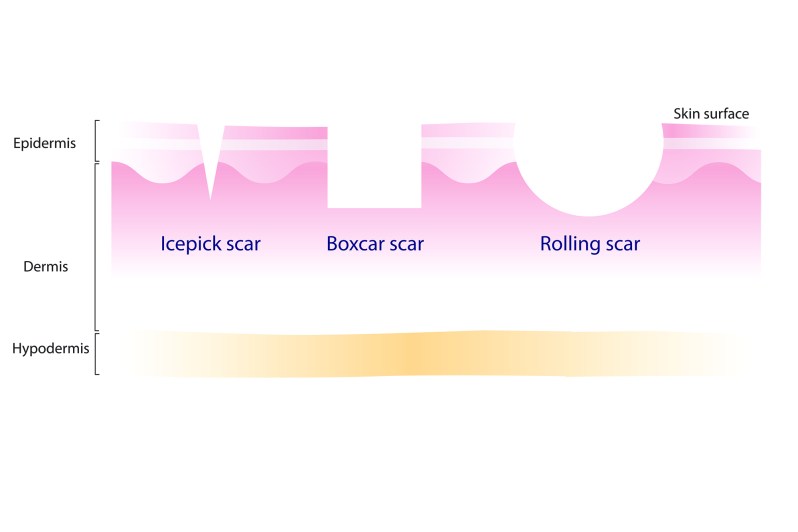
Let’s start things off with atrophic scars, which are the most common type of acne scars. If you dealt with serious breakouts in your youth that produced small scars along your face, they’re most likely atrophic or “depressed.” This means that the body was unable to regenerate tissue, creating small indents on the surface. Therefore, the key to treating these kinds of scars is to encourage new collagen growth.
When we talk about atrophic scars, we’re basically talking about three different types: Icepick, Box Car, and Rolling scars. Below, I’m going to describe what these scars look like and identify some at-home treatments you can try.
Ice pick

What they look like: Ice-pick scars are tiny, V-shaped indentations that run deep into the skin. Not only are they noticeable to the naked eye, but they’re incredibly difficult to treat because of how narrow and small they are. I should add that they’re typically caused by severe acne, like cysts and papules.
How to treat: While fully ridding your skin of ice-pick scars can be quite arduous, there are a few at-home treatments you can try. According to Dr. Gilbert, one of the most effective is to treat the area with a derma roller. Readily available online, these devices work to stimulate collagen growth by puncturing the skin with small tines. So, set a regular rolling routine and get ready to see your scars shrink!
Boxcar
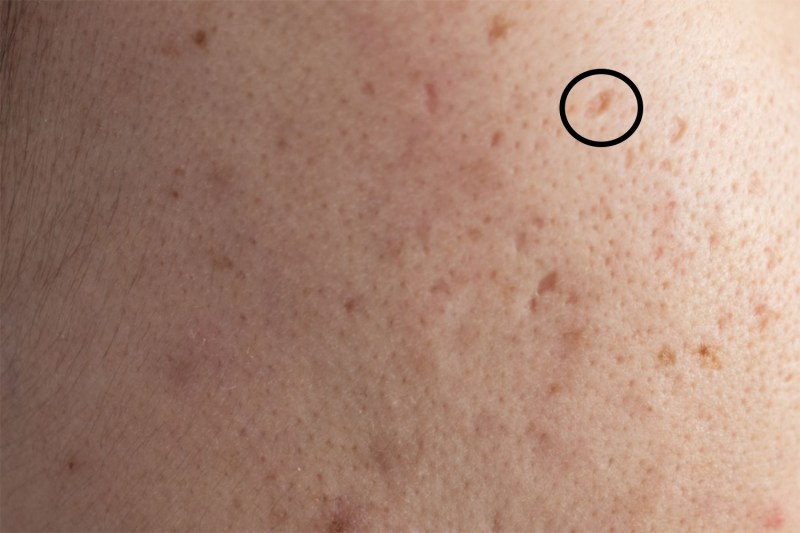
What they look like: Boxcar scars are sort of between icepick and rolling scars in terms of size. They’re round or oval in shape, so look like craters on your skin. Shallow boxcar scars are much easier to treat than deeper ones, but both have frustratingly strong staying power.
How to treat: Again, the best at-home treatment here seems to be a good ol’ pass of the derma roller. But, you could also try retinoids and alpha-hydroxy acids. As Dr. Gilbert puts it, both of these treatments (available over the counter and from your dermatologist) promote “collagen remodeling,” which works to alleviate the appearance of scarring and brighten the skin.
“While the results you get from using these are more subtle than those from a derma roller,” adds Gilbert,” they have the benefit of gradually fading post-acne pigmentation and smoothing out the skin texture, as well as helping to prevent future breakouts.”
Rolling
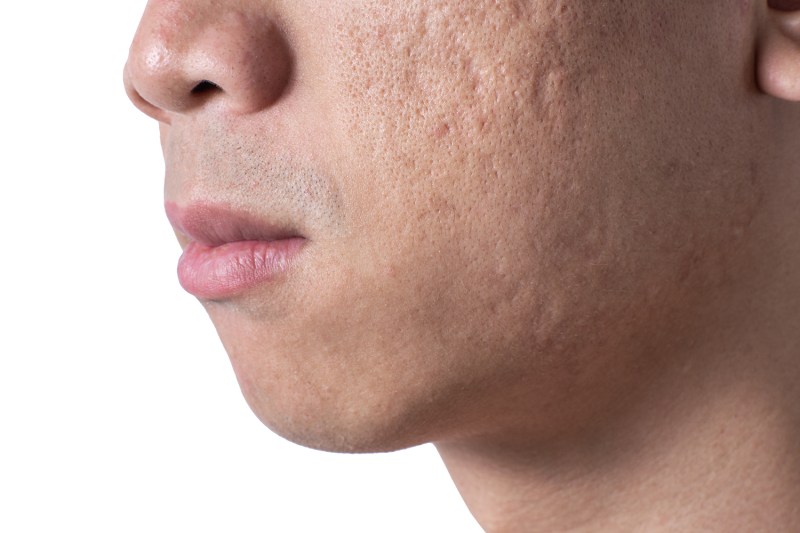
What they look like: Rolling scars are the shallowest of the atrophic bunch and are characterized by sloped edges and a “wavy” appearance. They most commonly appear in areas where the skin is slightly thicker, like the chin or lower jaw.
How to treat: The good thing about rolling scars is that they almost always fade over time! Woo! But, if you find that they’re sticking around, you may want to try hitting them up with a derma roller. Dr. Gilbert says that you could also try treating them with creams and ointments containing willow bark extract, kojic acid, or vitamin C.
Hypertrophic scars
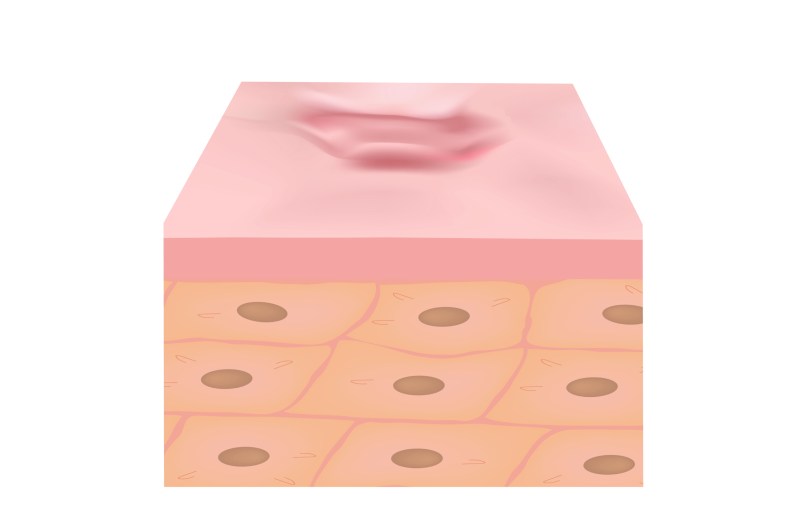
Hypertrophic scars are the opposite of atrophic ones in that they appear “raised” on the skin. Where atrophic scars are caused by a lack of collagen during the healing process, hypertrophic ones are caused by an excess of collagen. These types of scars most commonly appear on the chest or back.
If you’d like to treat a hypertrophic blemish, there are a few different methods you can try. Some experts suggest applying as much pressure to the scars as you can with either wraps or intense massage. You could also try applying an OTC onion extract to the scars, which may help heal and lighten the lesion.
Hyperpigmentation
While not technically a scar, hyperpigmentation (as caused by acne) can still be a headache to deal with. If you’re not familiar with the term, it basically just refers to any patch of skin that has become darker than the surrounding skin. As Dr. Gilbert explains:
“People often confuse post-inflammatory hyperpigmentation with scarring. Scarring is defined as a raised or depressed area of skin that often becomes apparent long after the acne lesion has healed. Pigmentary changes occur earlier, and can be pink or red usually in lighter skin types and dark in color in darker skin types.”
And though these pigmentary changes can seem really dramatic at first, they’re actually quite simple to treat. Either wait for them to fade over time, or apply a cream, ointment, or lotion made with willow bark extract, kojic acid, azelaic acid, or vitamin C.
Acne scar tips
To round out this guide, I thought I’d leave off with a few general tips from Dr. Gilbert. Everyone’s healing process is going to look different, but these ideas should help guide your treatment journey.
- Don’t underestimate the importance of sunscreen! According to Dr. Gilbert, sunscreen designed especially for acne-prone skin can “significantly reduce the time it takes for… pink or red or even dark spots to clear up.” So, make sure to throw on a little moisturizer with SPF every morning before you head out the door.
- Seek professional medical help before the scarring strikes. If you experience regular breakouts, Dr. Gilbert recommends teaming up with a dermatologist to create a plan for your skin. This will help prevent the formation of large nodular or cystic lesions.
- We all have different skin, so don’t worry too much if a certain treatment doesn’t work for you! The market is full of OTC and prescription resources that can help address your unique needs.
You may need more than sunscreen and moisturizer
Sometimes, acne scars and lesions are going to need a stronger remedy than an over-the-counter or even prescription treatment. The American Academy of Dermatology (AAD) says other treatments, such as resurfacing, skin tightening, and even surgery may be necessary to get rid of acne scars. Again, you’ll want to weigh the pros and cons with a professional to come up with a plan you’re comfortable with. You should also note you may not be able to completely nix acne scars. Discuss your goals and reality with your provider so you can manage expectations — sometimes, skin care can be a mental game, too. The more prepared and informed you are, the more satisfied you’ll be with your care.



